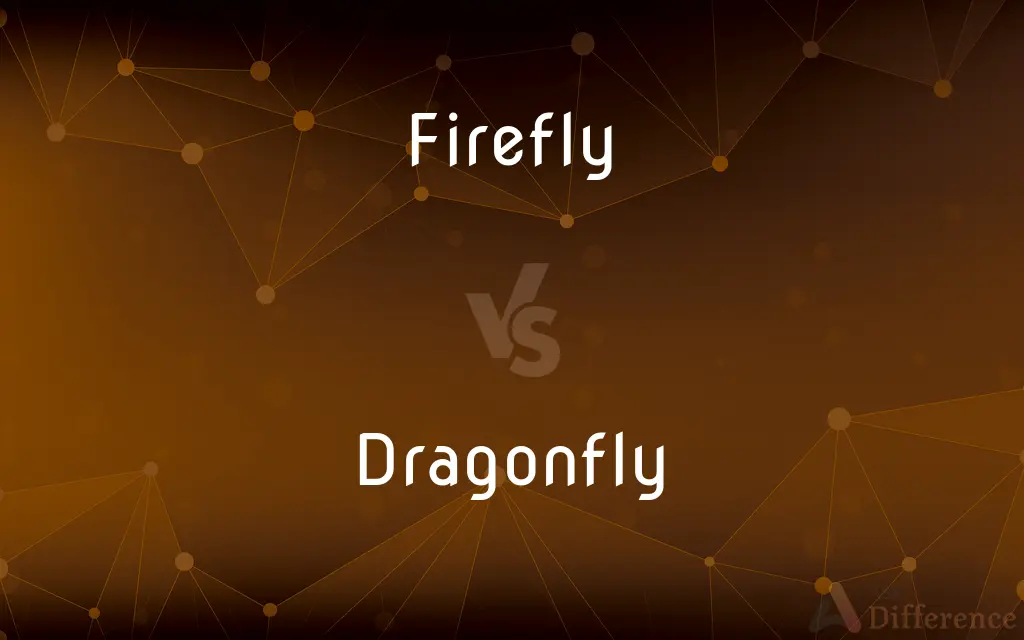Firefly vs. Dragonfly — What's the Difference?
By Tayyaba Rehman & Maham Liaqat — Updated on February 27, 2024
Fireflies are known for their bioluminescent ability to produce light, typically seen in evenings or at night, while dragonflies are daytime fliers recognized for their agile flight and predation skills, without bioluminescence.

Difference Between Firefly and Dragonfly
Table of Contents
ADVERTISEMENT
Key Differences
Fireflies and dragonflies, both belonging to the order of insects, exhibit distinct characteristics and behaviors that set them apart. Fireflies, part of the family Lampyridae, are celebrated for their remarkable ability to produce light through a chemical reaction in their abdomens. This bioluminescence is used for communication, particularly in mating rituals, and as a defense mechanism to ward off predators. Dragonflies, on the other hand, belong to the order Odonata and are admired for their masterful flight abilities. With strong, transparent wings and elongated bodies, dragonflies are efficient predators, capturing prey such as mosquitoes, flies, and other small insects mid-air. They are diurnal, spending their days hunting around water bodies like ponds, lakes, and wetlands.
Fireflies are mostly nocturnal, making their presence known through their intermittent glowing signals during twilight and evening hours. Dragonflies are also indicators of environmental health, particularly the quality of freshwater ecosystems.
The primary differences between the two lie in their lifestyle, bioluminescence, and ecological roles. Fireflies' bioluminescent ability is unique among insects and serves as a key identifier for the species. In contrast, dragonflies are recognized for their flying prowess and role in controlling insect populations, contributing to the balance of aquatic and terrestrial ecosystems. While fireflies use light to communicate and evade predators, dragonflies rely on their speed and agility to evade threats and capture food.
Both fireflies and dragonflies hold significant ecological importance and have captivated human interest for centuries, whether through the enchanting lights of fireflies on a summer night or the dragonflies' agile maneuvers over a pond. Their distinct characteristics not only highlight the diversity of insect life but also underscore the complexity of their respective roles within their ecosystems.
Comparison Chart
Taxonomic Order
Coleoptera
Odonata
ADVERTISEMENT
Key Feature
Bioluminescence for communication and defense
Agile flight and predatory efficiency
Activity Time
Nocturnal (active at night)
Diurnal (active during the day)
Habitat
Meadows, forests, marshes, and gardens
Near freshwater bodies like ponds, lakes, and streams
Diet
Mostly larvae feed on snails and worms; often don't eat
Predators of mosquitoes, flies, and other small insects
Ecological Role
Pollination, signaling, and reducing snail populations
Control insect populations, indicating water quality
Compare with Definitions
Firefly
Use bioluminescence for mating signals.
Fireflies flash patterns unique to their species to attract mates.
Dragonfly
Recognized by their elongated bodies and large wings.
The dragonfly hovered over the pond, searching for prey.
Firefly
Insects known for emitting light from their abdomens.
Children enjoy catching fireflies glowing in the dark summer nights.
Dragonfly
Spend early life in water.
Dragonfly larvae, known as nymphs, are aquatic predators.
Firefly
Predominantly nocturnal.
Fireflies are a common sight in many parts of the world, lighting up the night.
Dragonfly
Predatory insects, feeding on other small insects.
Dragonflies play a crucial role in controlling mosquito populations.
Firefly
Belong to the family Lampyridae.
There are over 2,000 species of fireflies within the Lampyridae family.
Dragonfly
Indicators of environmental health.
A diverse dragonfly population signals a healthy freshwater ecosystem.
Firefly
The Lampyridae are a family of insects in the beetle order Coleoptera with more than 2,000 described species. They are soft-bodied beetles that are commonly called fireflies, glowworms, or lightning bugs for their conspicuous use of bioluminescence during twilight to attract mates or prey.
Dragonfly
Members of the order Odonata.
Dragonflies and damselflies are both part of the Odonata order, differing mainly in wing structure and resting posture.
Firefly
May not eat.
Many fireflies focus on reproduction and do not feed.
Dragonfly
A dragonfly is an insect belonging to the order Odonata, infraorder Anisoptera (from Greek ἄνισος anisos, "unequal" and πτερόν pteron, "wing", because the hindwing is broader than the forewing). Dragonflies are characterized by large, multifaceted eyes, two pairs of strong, transparent wings, sometimes with coloured patches, and an elongated body.
Common Curiosities
Do dragonflies bite or sting?
Dragonflies can bite if handled but do not sting. Their bites are generally harmless to humans.
How long do fireflies and dragonflies live?
Fireflies live a few weeks, enough to mate and lay eggs. Dragonflies live for several months to a few years, including their time as larvae.
Can fireflies be found during the day?
While primarily nocturnal, fireflies can sometimes be seen resting during the day but are not active or luminescent until dusk.
Why do fireflies glow?
Fireflies glow to communicate, especially for attracting mates and sometimes to deter predators by signaling their toxicity.
How can I attract fireflies to my garden?
To attract fireflies, maintain a natural habitat with plenty of moisture, long grass, shrubs, and leave leaf litter and logs for larvae to thrive.
Are dragonflies beneficial to have around?
Yes, dragonflies are beneficial as they help control populations of harmful insects, including mosquitoes.
Can fireflies and dragonflies coexist in the same habitat?
Yes, they can coexist, especially in areas where their habitats overlap, like near water bodies surrounded by vegetation, but they occupy different ecological niches and are active at different times.
Are firefly populations declining?
Yes, firefly populations are declining in many areas due to habitat loss, pesticide use, and light pollution, among other factors.
How do dragonflies catch their prey?
Dragonflies catch their prey mid-flight with their feet, using their speed and agility to maneuver and capture insects.
What is the significance of fireflies' light colors and patterns?
The color and flashing patterns of fireflies' light are species-specific, used for identifying and attracting suitable mates.
Share Your Discovery

Previous Comparison
Banker vs. Wanker
Next Comparison
Cytoplasm vs. ProtoplasmAuthor Spotlight
Written by
Tayyaba RehmanTayyaba Rehman is a distinguished writer, currently serving as a primary contributor to askdifference.com. As a researcher in semantics and etymology, Tayyaba's passion for the complexity of languages and their distinctions has found a perfect home on the platform. Tayyaba delves into the intricacies of language, distinguishing between commonly confused words and phrases, thereby providing clarity for readers worldwide.
Co-written by
Maham Liaqat













































